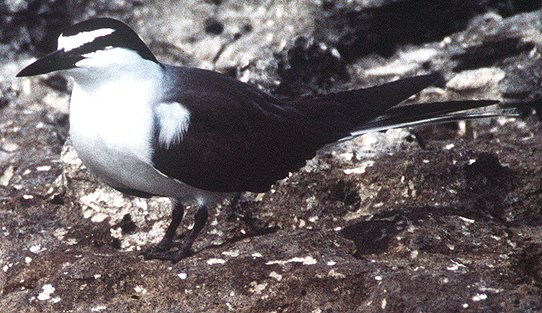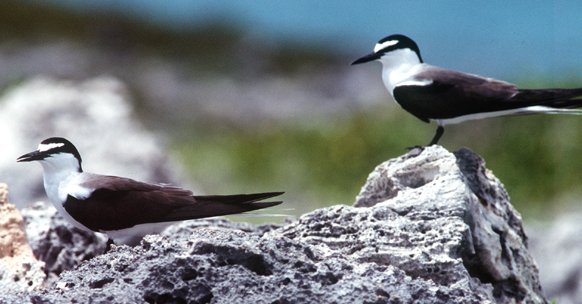| Bridled Tern
Sterna anaethetus Charrán Embridado, Gaviota Monja |
 |
|
Photo: B. Hallett
|
| Bridled Tern
Sterna anaethetus Charrán Embridado, Gaviota Monja |
 |
|
Photo: B. Hallett
|
|
IDENTIFICATION: Brown above and white below, with a white collar, black cap, white forehead, and long, forked tail. Length: 30-32 cm.; weight: 110-180 g. VOICE: A nasal, two-note call, given incessantly at the nesting colony. Audio (M. Oberle). HABITAT: Feeds at sea, often within 10 miles from shore. HABITS: The Bridled Tern dips to the sea surface from a short height to catch small fish, usually less than 6 cm. long. It occasionally eats squid or crustaceans near the surface. It perches on floating wood, plastic or rafts of seaweed in the open ocean, but often returns to land to roost at night. Some Caribbean birds may migrate to feeding grounds off West Africa after the breeding season. In May and June this tern builds a scrape nest under the protection of vegetation or rocks, and lays a single egg. The incubation period is 28-30 days, and the chick fledges 50-65 days after hatching. The Bridled Tern typically does not breed until it is four years old. STATUS AND CONSERVATION: Locally common in coastal Puerto Rico during the breeding season. The West Indian breeding population is estimated at 5,000-7,000 pairs. RANGE: Tropical oceans throughout the world, except the Central Pacific. Regularly seen during the breeding season in waters off the nesting colonies on Culebra, Monito and Mona Islands, La Cordillera Nature Reserve, and rocky offshore cays and cliff crevices between Isabela and Barceloneta, e.g. Cueva del Indio. TAXONOMY: CHARADRIIFORMES; LARIDAE; Sterninae |
 |
|
Photo: B. Hallett
|
|
References Bent, A.C. 1921. Life histories of North American gulls and terns. Smithsonian Instit. U.S. National Museum Bull. 113. (Reprinted by Dover Press, 1963). Burger, A. E. and A. D. Lawrence. 2000. Seabird monitoring techniques. Pp. 148-173 in Status and conservation of West Indian seabirds (E. A. Schreiber and D. S. Lee, eds.). Soc. Carib. Ornith., Special Pub. No. 1. Chardine, J. W., R. D. Morris, J. F. Parnell, and J. Pierce. 2000. Status and conservation priorities for Laughing Gulls, Gull-billed Terns, Royal Terns and Bridled Terns in the West Indies. Pp. 65-79 in Status and conservation of West Indian seabirds (E. A. Schreiber and D. S. Lee, eds.). Soc. Carib. Ornith., Special Pub. No. 1. Dammann, A.E. and D.W. Nellis. 1992. A natural history atlas to the cays of the U.S. Virgin Islands. Pineapple Press, Sarasota, FL. del Hoyo, J., A. Elliott, and J. Sargatal, eds. 1996. Handbook of Birds of the World, Vol. 3. Hoatzin to Auks. Lynx Edicions, Barcelona.
Erdman, D.S. 1967. Seabirds in relation to game fish schools off Puerto Rico and the Virgin Islands. Carib. J. Sci. 7:78-85. Haney, J. C., Lee, D. S. and R. D. Morris. 1999. Bridled Tern (Sterna anaethetus). No. 468 in The birds of North America (A. Poole and F. Gill, eds.). The Birds of North America, Inc., Philadelphia, PA. Harrison, P. 1983. Seabirds: an identification guide. Houghton Mifflin, Boston. Harrison, P. 1987. A field guide to seabirds of the world. Stephen Greene Press, Lexington, MA. Meier, A. J., R. E. Noble, and H. A. Raffaele. 1989. The birds of Desecheo Island, Puerto Rico, including a new record for Puerto Rican territory. Carib. J. Sci. 25:24-29. Raffaele, H.A. 1989. A guide to the birds of Puerto Rico and the Virgin Islands. Princeton. Raffaele, H.A. 1989. Una guía a las aves de Puerto Rico y las Islas Vírgenes. Publishing Resources, Inc., Santurce, PR. Raffaele, H.A., J.W. Wiley, O.H. Garrido, A.R. Keith, and J.I. Raffaele. 1998. Guide to the birds of the West Indies. Princeton. Rolle, F. J., H. Heatwole, R. Lewins, and F. Torres. 1964. Faunal notes on Monito Island, Puerto Rico. Carib. J Sci. 4:321-322. Schreiber, E. A. and D. S. Lee. 2000. West Indian seabirds: a disappearing natural resource. Pp. 1-10 in Status and conservation of West Indian seabirds (E. A. Schreiber and D. S. Lee, eds.). Soc. Carib. Ornith., Special Pub. No. 1. Schreiber, E. A. 2000. Action plan for conservation of West Indian seabirds. Pp. 182-191 in Status and conservation of West Indian seabirds (E. A. Schreiber and D. S. Lee, eds.). Soc. Carib. Ornith., Special Pub. No. 1. Wiley, J. W. 2000. A bibliography of seabirds in the West Indies. Pp. 192-225 in Status and conservation of West Indian seabirds (E. A. Schreiber and D. S. Lee, eds.). Soc. Carib. Ornith., Special Pub. No. 1. Next related species in taxonomic order Previous related species in taxonomic order |